‘I just wanted to organize this mess’: An oral history of the Lumascape
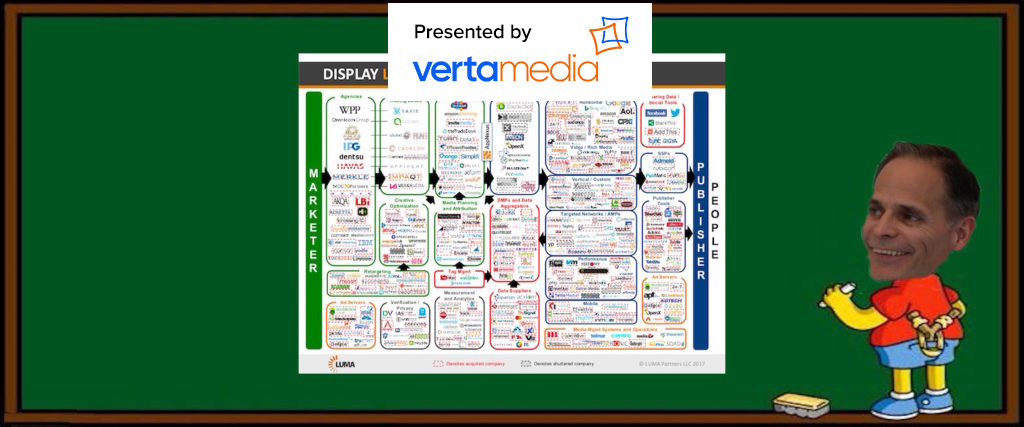
Whether they’re listening to a panel, chatting in the hallways or sitting in an airplane on their way to Cologne, Germany, Dmexco attendees will be bombarded by the Lumascape this week. The Lumascape is a series of charts that organize the madness of ad tech by grouping together similar companies on a single page. But before the charts from investment bank Luma Partners racked up more than 6 million views on the company’s website and spawned endless debate about fragmentation in the ad industry, it was merely a Powerpoint presentation given at an industry event.
Ever since the Lumascape made its public debut in 2010, ad tech apologists and detractors alike have deferred to the Lumascape’s symbolism whenever they express their feelings about ad tech. The apologists point to the nearly 5,000 companies on today’s Lumascape as a sign that ad tech is an innovative industry. Detractors use the Lumascape as a pejorative because they think that ad tech has become too complex and is taking too much money out of the ad supply chain.
Here is the story of how the Lumascape came to be, from some of those who helped popularize it. Responses have been edited for length and clarity.
The Ur-scape
Before Luma Partners even existed, about 10 years ago investment banks were putting together charts that organized ad tech companies into various categories such as ad servers, ad networks and data aggregators. These charts laid the groundwork for the Lumascape similar to how Carl Perkins influenced The Beatles.
Terence Kawaja, CEO, Luma Partners: The Lumascape is just an industry map and those things have been done for years. It wasn’t the first time someone laid out different companies in an industry.
Mike Baker, CEO, DataXu: Like all good ideas, the Lumascape was borrowed from Nick MacShane’s early landscape work.
Nick MacShane, founder, Progress Partners: We used to carry around a book of industry maps. We just did them in spreadsheets. We were trying to figure out where companies should be placed in the ad tech economy.
Kawaja: There were a number of banks that had those, and Nick was early on his.
MacShane: Terry took my nascent idea and ran with it like a pro.
Kawaja: I remember seeing Nick’s map, but I don’t remember thinking, “I’ll improve upon it.” I just sat down and wanted to organize this mess.
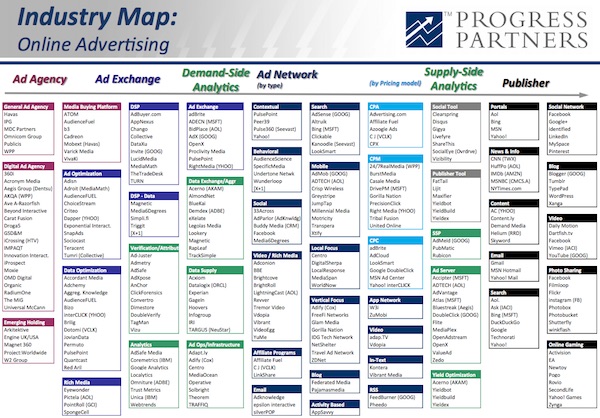
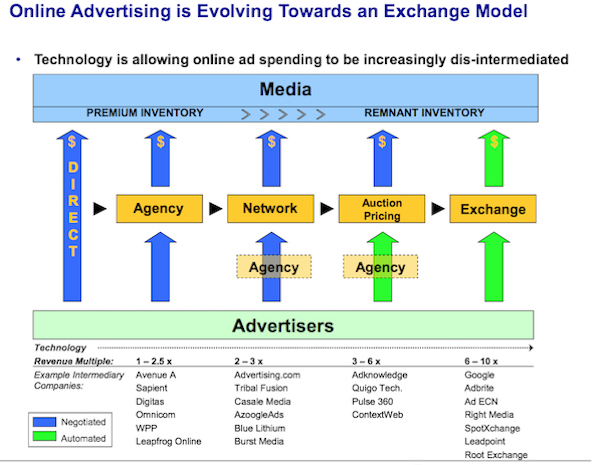
The presentation
On May 3, 2010, Kawaja gave a presentation about consolidation in ad tech at the Interactive Advertising Bureau’s Networks and Exchanges Conference. This event would later become known as the Lumascape’s coming-out party.
Eric Franchi, co-founder, Undertone: I remember the first time Terry presented it. It was very impressive and he became really influential shortly thereafter.
Kawaja: In 2009, for my own internal purposes I put on a page all the different players and I crudely tried to categorize them. People privately would ask if they could get a copy of it and it took on a life of its own. So in 2010, I included it in a deck that I delivered to the IAB.
Patrick Dolan, evp and COO, IAB: I recall that it was probably the best representation that I had seen of the advertising landscape. The way he laid it out was something that hadn’t been seen yet.
Franchi: I remember it being funny. And it used animation in a cool way to show Google coming to eat the whole landscape like Jaws.
Kawaja: I had the Jaws theme music and everything.
MacShane: In our maps, we would list companies by their names in text. Terry was very smart to use logos because company CEOs want to see their logo on his maps.
Brian Andersen, partner, Luma Partners: If it just had words, I don’t think it would have gotten any traction.
Kawaja: The fact that we used logos, people looked at it and said ‘Oh, I get it,’ and it meant something to them.
Franchi: When we changed the Undertone logo a few years later, part of the marketing checklist was to make sure Luma updated it correctly.
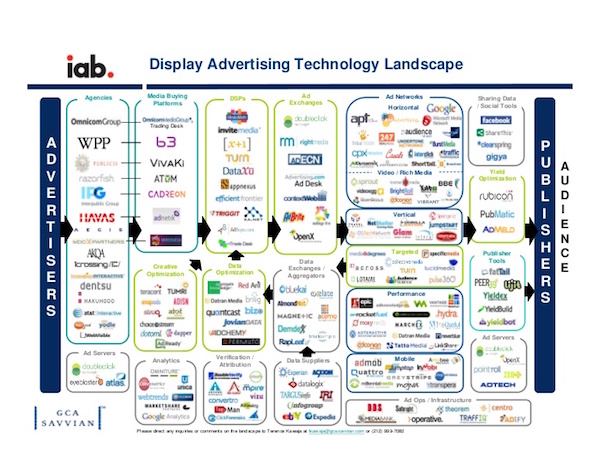
The branding
If you look at Kawaja’s slide from the IAB event, the word “Luma” is nowhere to be found on it. Similar to how Blue Ribbon Sports found its groove after rebranding to become Nike, the Lumascape became an ad tech phenomenon due to nifty marketing.
Kawaja: In 2011, Amir Efrati of The Wall Street Journal wrote about these industry landscapes.
Amir Efrati, senior reporter, The Information: These sorts of charts have been created for decades by bankers. But [Kawaja] appears to be the first one to use his firm’s chart for marketing purposes, and that made him a household name in ad tech. It was a brilliant move and he got a lot of mileage out of that, for years.
Kawaja: The name of my slide at the time was the Digital Advertising Technology Landscape. I was like “God, that’s a mouth full, I should brand this thing.” With a few minutes to go before the deadline, I had this epiphany of changing the name so we could shorten it and brand it. I resent the files, and they published it the next day, and that’s how it became the Lumascape.
Efrati: His Lumascapes became indispensable at a critical time in the display ads evolution. Confusion was rampant, and his slides restored some order for practitioners and journalists alike.
Michael Katz, CEO, mParticle: I think what made it so popular is that it brought order to all the chaos.
Davis Rosborough, vp, Progress Partners: I remember when Luma advised Admeld’s sale to Google in 2011, Google linked to the Lumascape in their blog post announcing the deal.
MacShane: Terry has done a great job establishing a brand. It has become almost like a verb. “Has your company been Lumascaped?”
Dolan: There was some debate about who should and shouldn’t be on it.
Kawaja: The first thing I’ll say about the Lumascapes is they are wrong because by definition they have to be. There are companies that expand across multiple categories, but my constraint is I can’t put them in multiple locations because I don’t have the space. All I have is a 8.5 by 11 inch piece of paper.
Ari Paparo, CEO, Beeswax: I know that they employ underage foreign labor to shrink and place the logos. They are too small for adults to handle.
Susan Marshall, chief administration officer, Luma Partners: I think once Terry had some [Lumascape] socks made as a test, but the logos were so small.
Dolan: It really put that complex ecosystem on one page. It was definitely the start of something for sure.
Kawaja: I thought it would have jumped the shark by now. But forget the British Empire, the sun never sets on the Lumascape.
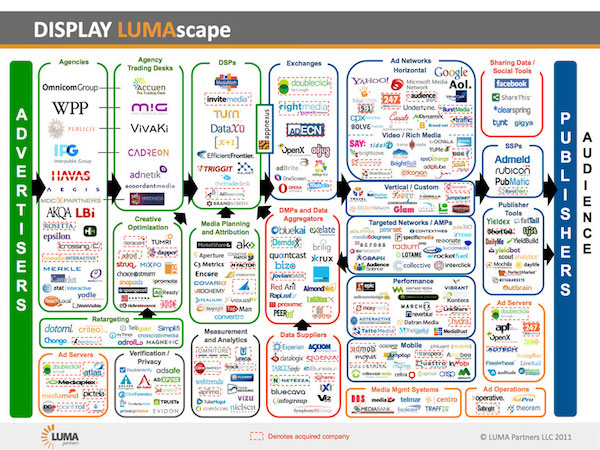
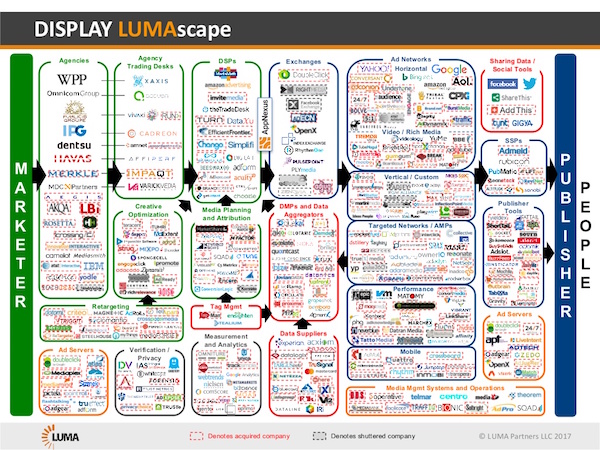
More in Marketing

How the MAHA movement influenced food and beverage brands in 2025
The MAHA movement has come to stand for different things in different people’s eyes, depending on which initiatives they most closely follow.

Why Georgia-Pacific is turning its programmatic scrutinty to the sell side
The company is turning its attention to the sell side, zeroing in on the ad tech firms that move inventory for publishers — the supply-side platforms.

Future of Marketing Briefing: Why ‘just good enough’ is generative AI’s real threat to marketers
When characters and mascots are allowed to live inside generative systems, they stop being event-based and start becoming environmental.








